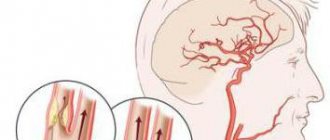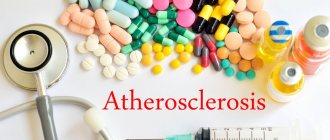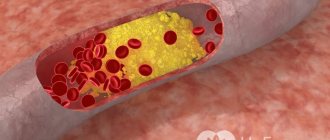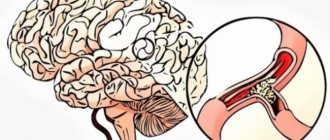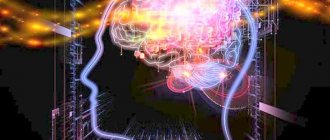The essence of pathology
Vascular insufficiency provokes a decrease in local or general blood flow, which is caused by insufficiency of veins and arteries against the background of a decrease in their lumen and loss of elasticity. This provokes a decrease in the volume of blood moving through them, oxygen deficiency, and disruption of the functioning of organs and systems.
In medical practice, a distinction is made between systemic (general) and regional (local) vascular insufficiency. According to the nature of the course, the pathology is classified as acute or chronic.
As an independent disease, this condition is diagnosed extremely rarely; more often it is combined with impaired functioning of the heart and blood vessels.
Important! Vascular insufficiency is a secondary pathology that develops due to disruption of the cardiovascular system.
Diagnostics
Problems with the blood vessels of the head and neck can begin at any age, so everyone should know the main symptoms of the pathology. This information can subsequently help in diagnosing pathology.
Ultrasound. In this case, the standard examination procedure is ineffective, so specialists conduct the following types of examination of cerebral vessels: duplex scanning, Dopplerography, echotomography or transcranial Dopplerography. Neurosonography is performed in infants.
CT or MRI. With their help, a diagnostician can determine the area of damage to the brain substance, the size of the area of necrosis and the condition of the organ as a whole.
Angiography. Allows you to detect areas of obstructed cerebral circulation in the head, the degree and order of filling of blood vessels. Using it, you can obtain data on the presence of additional blood routes when the main arteries and veins are blocked.
Rheoencephalography. This method of studying the vascular system of the brain is based on recording the electrical resistance of nervous tissue when a weak high-frequency electric current is passed through it. After decoding, the specialist receives information about the elasticity of the walls of blood vessels, the presence of neoplasms and aneurysms.
Why does pathology develop?
The causes of vascular insufficiency often lie in the anatomical aging of the body, because with age, the walls of blood vessels weaken, lose tone and natural elasticity. The risk group for the disease also includes patients with various heart defects. It is these factors that are considered leading when considering the causes of pathology.
In elderly patients, the disease develops against the background of the following conditions:
- hypertension;
- various heart defects;
- coronary heart disease;
- infectious myocardial lesions.
Each of these diseases has its own provoking factors, but they all cause the risk of developing vascular insufficiency.
Against the background of a persistent increase in blood pressure, vasoconstriction occurs, the rate of contraction of the heart muscle increases, its hypertrophy develops, decompensation of the atrophied myocardium occurs, and coronary heart disease occurs. That is, we can say with complete confidence that all factors that provoke coronary artery disease are related to the causes of vascular insufficiency.
Fainting is considered a common form of vascular insufficiency. This condition often develops due to standing up quickly. This often occurs in people with asthenic syndrome after severe fright, emotional shock, or after a long stay in a stuffy room. Predisposing causes include anemia and chronic fatigue.
A common cause of vascular insufficiency is various heart diseases
Such severe pathologies as pneumonia, acute pancreatitis, sepsis, and purulent appendicitis can provoke collapse. Another reason is a sharp drop in blood pressure due to poisoning with mushrooms or chemicals. Sometimes vascular collapse develops due to electrical shock due to severe overheating of the body.
Symptoms
Symptoms of vascular insufficiency are a set of symptoms characterized by a decrease in blood pressure, which entails a decrease in the volume of blood flowing through the veins and arteries. In this case, the patient experiences dizziness, nausea, and less often vomiting develops. Some patients experience dysfunction of the vestibular apparatus, numbness of the extremities, and decreased sensitivity. Signs of vascular insufficiency include fatigue, loss of ability to work, apathy, headaches, and irritability.
Signs of acute failure:
Read more: Cardiovascular failure in children
- blurred vision;
- increased heart rate, the patient feels heartbeats;
- general weakness;
- pallor of the dermis;
- difficulty speaking, confusion.
In addition to general symptoms, with acute vascular insufficiency, very serious complications can develop - fainting, collapse and vascular shock.
Fainting
Fainting is clouding and loss of consciousness that lasts no more than 5 minutes. This condition is usually preceded by symptoms called presyncope in medical practice. These include:
- nausea;
- gagging;
- ear ringing;
- sharp darkening and spots in the eyes;
- increased sweating;
- dizziness;
- difficulty breathing.
The person loses consciousness and stops responding to surrounding people, events and sounds. In this case, the skin becomes pale and the pupils are greatly constricted. They do not respond to light, the pressure drops, and dull tones are heard in the heart.
Fainting is a common complication of vascular insufficiency
Important! A person recovers from a fainting state on his own; most often, no medical measures are required.
Collapse
A dangerous complication during which oxygen starvation of the brain occurs and disruption of its functions is collapse. Its onset can be determined by the following signs:
- general weakness, depression;
- a bluish discoloration of the skin is noted in the lip area;
- intense sweating;
- the dermis and mucous membrane of the mouth becomes pale;
- body temperature drops;
- the patient becomes stuck and does not react to surrounding people and events.
A person’s facial features become sharper, blood pressure decreases, breathing becomes shallow, and heartbeats become muffled.
Emergency care for acute cardiovascular failure accompanied by collapse should be immediate. If the patient is not hospitalized within an hour, there is a risk of developing dangerous complications and death.
Shock
Shock is another complication that occurs in people diagnosed with acute venous or arterial insufficiency. Shock is a severe deterioration in condition, disruptions in the functioning of the central nervous and cardiovascular systems. In this case, the following manifestations are observed:
- decrease in pressure below 80 mmHg. Art.;
- heart rate drops to 20 beats per minute;
- lack of urine output;
- increased heart rate;
- confusion, sometimes loss of consciousness;
- sticky sweat;
- pallor of the dermis, blueness of the extremities.
In patients with shock, the acid-base balance of the blood changes. Another characteristic symptom is “white spot” syndrome. If you press your finger on the area of the back of the foot, after pressing, a white spot on the skin remains for at least 3 seconds.
Shock requires immediate hospitalization of the person with resuscitation measures.
A person cannot get out of this state on his own, so if shock develops, the patient must be immediately taken to the hospital. Therapy is carried out in intensive care.
Traditional methods and other methods of treatment
Nowadays, it has already been proven that dosed moderate physical activity helps to cure many chronic cerebrovascular diseases.
If there are no contraindications, the doctor will recommend special exercises (physical therapy), which the patient must perform daily to maintain the normal function of all blood vessels. Also, the treatment program must include a diet with limited salt and fat, low-calorie nutrition systems that will help a person lose weight. For rehabilitation, the patient is advised to work with a psychologist or speech therapist.
Alternative treatment can serve as a good method for preventing acute complications of cerebrovascular diseases, but only in combination with traditional treatment.
The following recipes are effective:
- Cut the peony root into pieces, pour a teaspoon of it with a glass of boiling water, leave for 2 hours. Strain and drink a tablespoon four times a day.
- Grind the lemon pulp. Separately, pour 2 tablespoons of pine needles into 400 ml and leave for an hour. Strain the broth, pour lemon over it, consume this remedy before meals, 50 ml three times a day.
- Squeeze beet juice and combine with honey in equal parts.
Take 3 spoons twice a day.
- Combine a glass of horseradish, lemon and red currant juice each, add a glass of honey. Take a tablespoon three times a day.
- Consume honeysuckle berries as often as possible, which relieve vasospasm and headaches.
Chronic course of cerebrovascular insufficiency
Chronic cerebrovascular insufficiency is accompanied by hypoxia, that is, oxygen starvation of brain tissue. The causes of this condition include atherosclerosis, neurocircular dystonia, arterial hypertension, vascular diseases in the neck, and pathologies of the heart muscle.
There are several stages of development of CSMN:
- The first one has a latent course, here minor changes develop in the walls of blood vessels, the functioning of the brain is not impaired.
- The second is characterized by the appearance of signs of microstrokes. The patient notes numbness of the face and limbs, dizziness, headache, sometimes there is a lack of coordination of movements, weakness, decreased vision, etc.
- Third - at this stage, signs of dyscirculatory encephalopathy develop, movement disturbances, memory loss, and a drop in mental activity occur. A person begins to have poor orientation in time and space.
- Fourth, here the symptoms of brain failure are greatly aggravated. Patients experience frequent strokes and the patient requires immediate treatment.
People with chronic cerebrovascular insufficiency sometimes experience a serious complication – cerebral edema. This condition is very difficult to respond to drug therapy. If emergency treatment is not provided, death occurs in most cases.
Causes
Encephalopathy of complex origin may have several causes. The most common cause is impaired cerebral circulation and, as a result, a deficiency of oxygen and nutrients in brain cells. If the disruption of blood flow is prolonged, some of them die.
On this topic
- Encephalopathy
5 types of cerebral encephalopathy
- Natalia Sergeevna Pershina
- March 26, 2020
Impaired blood flow can occur from an unhealthy lifestyle, low mobility, consumption of large amounts of fatty and sweet foods, abuse of cigarettes and alcoholic beverages.
There are also hereditary causes. Signs of encephalopathy may appear after severe injuries, poisoning, or prolonged oxygen deprivation. Stress and high physical and mental stress make the signs of the disease more pronounced and provoke its development.
Acute cardiovascular failure
Acute cardiovascular failure is a sharp decrease in the frequency of heart muscle beats, resulting in a drop in blood pressure in the vessels and impaired circulation of the lungs and heart.
A common cause of this condition is myocardial infarction. Other causes of the disease include inflammation of the heart muscle (myocarditis), heart surgery, pathologies of the valves or chambers of the organ, stroke, brain injury, and more. Classification of heart failure according to ICD10 – I50.
Acute cardiovascular failure is accompanied by many unpleasant symptoms
There are failures of the left and right ventricles of the heart. In the first case, the following symptoms are noted:
- shortness of breath - from minor breathing difficulties to suffocation;
- discharge from the upper respiratory tract in the form of foam, accompanied by a strong cough;
- wheezing in the lungs.
The patient is forced into a sitting or semi-sitting position, with his legs lowered down.
Clinical picture of right ventricular failure:
- swelling of the veins in the neck;
- bluish coloring of the fingers, limbs, ears, chin, tip of the nose;
- the skin acquires a slight yellowish tint;
- the liver enlarges;
- mild or severe swelling occurs.
Intensive therapy for acute cardiovascular failure is carried out in a hospital setting. If the cause of the disease is an abnormal heart rhythm, medical measures are aimed at restoring it. In the case of myocardial infarction, therapy involves restoring blood flow in the affected artery. For this purpose, thrombolytic drugs are used. These medications dissolve blood clots, thereby restoring blood flow. In case of myocardial rupture or damage to the heart valves, the patient requires urgent hospitalization followed by surgical treatment and care.
Preventive measures
To prevent illness, you should follow these tips:
- adhere to a low-cholesterol diet;
- get rid of all bad habits;
- control your blood pressure;
- avoid any overload;
- reduce weight;
- get rid of stress and its consequences;
- after 45 years of age, undergo regular preventive examinations;
- if necessary, take antiplatelet agents and drugs to optimize cerebral blood flow for preventive purposes.
Course of the disease in children
The reasons for the development of open vascular insufficiency in children include large blood losses as a result of injuries, severe dehydration, and loss of minerals due to conditions such as vomiting and diarrhea. In addition, provoking factors include severe intoxication of the body and severe allergic reactions.
Cardiac and vascular failure in children manifests itself in shortness of breath, which occurs first during physical exertion, then at rest. Shortness of breath may worsen during conversation or when changing body position. Breathing is often difficult, the child gets tired quickly and lags behind in development. Sleep and general well-being are disturbed. In the later stages, a dry cough and bluish skin appears. Sometimes fainting, collapse and even shock occur.
Presyncope symptoms in children are similar to those in adults. Children stop responding to treatment and there is convulsive readiness. Spasms occur both in individual muscle groups and throughout the body.
Manifestations of deficiency in children are similar to those in adults
Collapse in children occurs in several stages:
- The first is that the baby experiences excessive excitability, the heart rate increases, and signs of tachycardia appear.
- Second, here the pulse rate drops, the child’s consciousness slows down, the skin acquires a grayish tint, the amount of urine produced decreases, and respiratory function is impaired.
- Third - the consciousness of the little patient is disturbed, there is no reaction to the outside world, blue spots appear on the skin, the pulse rate, blood pressure, and body temperature are greatly reduced.
A common phenomenon in children against the background of acute vascular insufficiency is hypovolemic shock. In young children, dehydration quickly occurs, which is explained by the imperfection of all processes in childhood.
Important! If fainting, collapse or shock develops in children, the child should be immediately taken to the hospital.
Prevention of pathology
Prevention of vascular insufficiency consists primarily in preventing diseases that can provoke this condition. To prevent pathology, you should be careful about your diet, reduce your consumption of foods rich in cholesterol, and give up fatty, fried, and smoked foods. Measures to prevent heart and vascular disease include physical education, frequent walks in the fresh air, giving up bad habits, and adequately assessing stressful situations.
If a person experiences any negative symptoms of the heart, it is recommended to undergo an examination, including methods such as stress tests for cardiovascular diseases, ECG monitoring, vascular tomography, etc. People suffering from hypertension need to regularly measure their blood pressure and take antihypertensive medications.
Physiotherapy
Physical exercises for encephalopathy increase the tone of the whole body, promote the supply of oxygen and nutrients to brain tissues, maintain and improve motor functions, and regulate the processes of inhibition and excitation of the brain.
The most suitable exercises for encephalopathy: walks in the park, sports or Nordic walking, swimming, dancing.
The complex necessarily includes breathing exercises that completely or partially eliminate oxygen starvation.
On this topic
- Encephalopathy
All about dyscirculatory encephalopathy stage 2
- Natalia Sergeevna Pershina
- March 26, 2020
To maintain brain activity, not only physical, but also mental exercise is recommended. Various board games, checkers, chess, and cards are suitable for this.
To prevent encephalopathy of complex origin, it is important to exercise, eat healthy foods, and avoid bad habits, injuries and poisoning.






